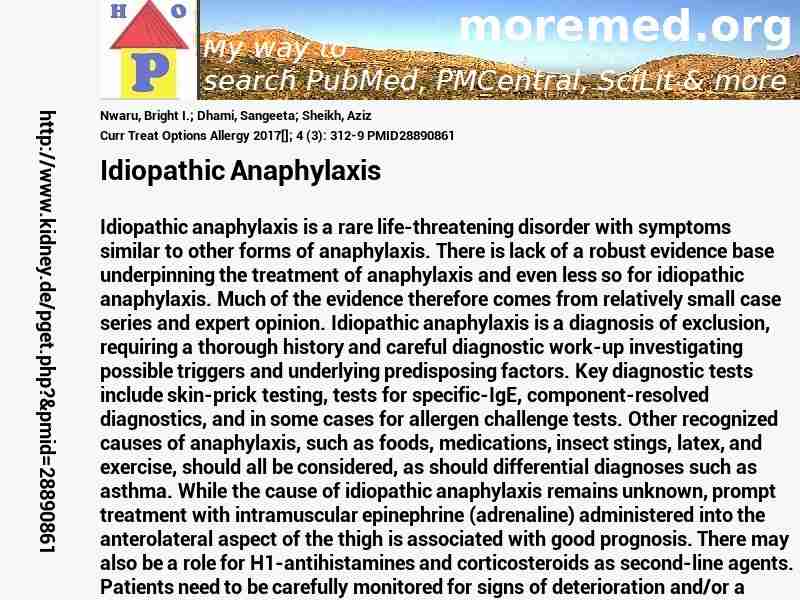
|
10.1007/s40521-017-0136-2
http://scihub22266oqcxt.onion/10.1007/s40521-017-0136-2

C5569651!5569651!28890861
 free free
 free free
 free free
Warning: file_get_contents(https://eutils.ncbi.nlm.nih.gov/entrez/eutils/elink.fcgi?dbfrom=pubmed&id=28890861&cmd=llinks): Failed to open stream: HTTP request failed! HTTP/1.1 429 Too Many Requests
in C:\Inetpub\vhosts\kidney.de\httpdocs\pget.php on line 215
|  
Warning: imagejpeg(C:\Inetpub\vhosts\kidney.de\httpdocs\phplern\28890861.jpg): Failed to open stream: No such file or directory in C:\Inetpub\vhosts\kidney.de\httpdocs\pget.php on line 117
 Curr+Treat+Options+Allergy 2017 ; 4 (3): 312-9 Curr+Treat+Options+Allergy 2017 ; 4 (3): 312-9
Nephropedia Template TP
gab.com Text
Twit Text FOAVip
Twit Text #
English Wikipedia
|
Idiopathic Anaphylaxis #MMPMID28890861Nwaru BI; Dhami S; Sheikh ACurr Treat Options Allergy 2017[]; 4 (3): 312-9 PMID28890861show ga
Idiopathic anaphylaxis is a rare life-threatening disorder with symptoms similar to other forms of anaphylaxis. There is lack of a robust evidence base underpinning the treatment of anaphylaxis and even less so for idiopathic anaphylaxis. Much of the evidence therefore comes from relatively small case series and expert opinion. Idiopathic anaphylaxis is a diagnosis of exclusion, requiring a thorough history and careful diagnostic work-up investigating possible triggers and underlying predisposing factors. Key diagnostic tests include skin-prick testing, tests for specific-IgE, component-resolved diagnostics, and in some cases for allergen challenge tests. Other recognized causes of anaphylaxis, such as foods, medications, insect stings, latex, and exercise, should all be considered, as should differential diagnoses such as asthma. While the cause of idiopathic anaphylaxis remains unknown, prompt treatment with intramuscular epinephrine (adrenaline) administered into the anterolateral aspect of the thigh is associated with good prognosis. There may also be a role for H1-antihistamines and corticosteroids as second-line agents. Patients need to be carefully monitored for signs of deterioration and/or a possible protracted or biphasic reaction. Patients with frequent episodes of anaphylaxis (e.g., six or more episodes/year) should be considered for preventive therapy, which may include corticosteroids, H1- and H2-antihistamines, and, in some cases, mast cell stabilizers such as ketotifen. Alternative immune-suppressants (e.g., methotrexate) and anti-IgE may rarely also need to be considered. In many cases, the frequency of anaphylaxis declines such that regular use of corticosteroids can be discontinued after 9?12�months. Pediatric patients should be treated with similar regimens as adults, but with appropriate dose adjustments. Patients should carry their self-injectable epinephrine and other emergency medications at all times in order to deal with emergency situations.�
  
DeepDyve
Pubget Overpricing | 
|